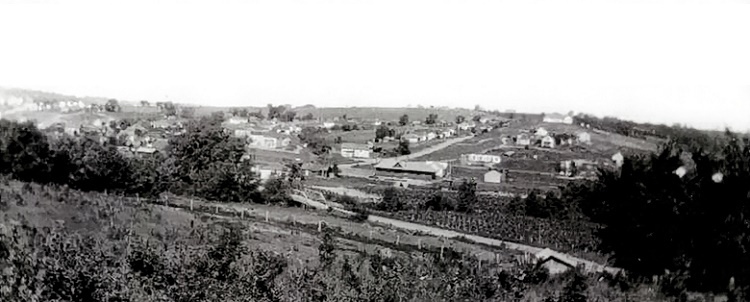Most people today see Iowa as an agricultural state with wide open spaces, but the state has a long history that has left behind a trail of ghost towns worth visiting.
The building of the railway in the state and the early coal mining activities also contributed to the creation of ghost towns.

Some of Iowa’s more interesting ghost towns include:
1. Angus, Iowa
Angus was one of the largest coal producing towns in Iowa. The town was located on the border between Greene and Boone counties. It was established in the 1870s by farming settlers in the area but soon grew into a mining town when coal was discovered in the nearby fields.
At its peak in the 1880s, the town had about eight coal operations with the biggest being the Climax Coal Company and a population of about 7,000 residents. The town was served the St. Louis and Minneapolis Railroad (Mud Line). Angus had many businesses that included restaurants, bars, general stores, saloons, churches, and schools.
The town began to decline in the 1890s following the decline in coal operations in the area and the closure of the Mud Line Railroad station in the town.
Today the only remnants of the town are a monument to honor the town’s Whiskey Row, a curved street, and a cemetery. Much of the original town site has been turned into a farm field with little evidence that it ever existed today.
2. Buxton, Iowa
Buxton was another large coal mining town in Iowa. Coal was discovered along the Bluff Creek in 1888 leading to the creation of the town. The Consolidated Coal Company and a number of other small companies had coal operations around the town.
Buxton was named after a nearby J.E. Buxton coal mine owned by the Consolidated Coal Operation. The Consolidated Coal Company employed mostly blacks and immigrants from Sweden, wales, and Slovakia to work in its mines making Buxton an African American dominated town.
At its peak, the town had a population of over 5,000 people and a bank, schools, a post office, an Opera house, a company store and many other businesses.
The town began to decline in the 1920s following a decline in the mining operations in the area. The last mine was closed down in 1927 and the town was completely abandoned thereafter. It gained fame in the 1980s following studies by archaeologists who tried to redevelop the lives of the successful black community of the town during the early days of coal mining.
3. Powdertown, Iowa
Powdertown is located between Summitville and Keokuk off Highway 218. The DuPont Company established the Iowa Powder Mills in Mooar in 1880 leading to the growth of a settlement that created Powdermill.
The mill grew rapidly to become the largest powder mills in the world by 1901. The mills formed a complex institution around the town made up of the powder plants, a railway line to transport the powder, a wooden box factory, two company villages, and company residence. To run these operations, the town had over 1000 residents who created a booming town with all manner of businesses, a post office, a church, and a school.
Following the end of the World War II, the need for powder declined forcing the company to close shop in 1949. The company then destroyed about 67 of its own buildings and majority of the town people left. Today a few houses still stand and campground can be found at the original site of the town.
Some of the remaining residents have plans to preserve some of the company’s compound although most of the remaining structures are completely run down.
4. Conover, Iowa
This is a ghost town in Winneshiek County, Iowa. The town was established in 1864 when the McGregor Western Railroad Company built a track to Calmar through the then small village of Conover. Soon a town was laid out and by August of 1865 it has over 200 buildings with about 32 saloons, general stores and other businesses. At its peak, the town has about 1500 inhabitants.
Conover began to decline in 1869 when a fire razed down a section of the town and some of its residents moved out. The same year the railroad depots, the side tracks, and the freight house were transferred to Calmar forcing the remaining residents to move to Calmar.
Today only the rail tracks and a few rundown buildings remain at the site.
5. Unique, Iowa
Unique was an important town in what is now the Weaver Township of Humboldt County in Iowa. The town was established in 1873 with the belief that a railway line would pass through it. A post office was established in 1878, a school in 1879 and a Methodist Church in 1889. When the railway engineers overlooked the town, the post office was closed in 1902 while the school closed down for the last time in 1944.
Today a metal sign for the town can still be seen on the site of the original town, and that’s about it.
6. Shady Grove, Iowa
Shady Grove is located between Jesup and Brandon at the Junction of County roads D47 and V65 in Buchanan County, Iowa. The town was established in 1857 on the western edge of what is now Jefferson Township.
The town had several businesses including a post office, a machine dealership, a general store, a creamery, a church and a school. The town, however, failed to grow and by 1958 the population had dropped to about 25 people.
Today the only remaining part of the town is the old Shady Grove Cemetery under the care of the Buchanan County Historical Society and foundations of a few of the original buildings. There was renewed interest in the area in the early 2000s as lots were being sold for holiday homes and now there are a number of new structures near the town site.
Next: Gold in Iowa – Prospecting Locations







